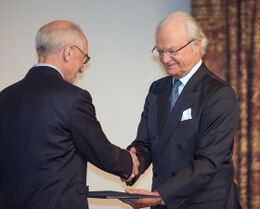Biography:Yakov Eliashberg
Yakov Eliashberg | |
|---|---|
 Eliashberg in 1988. | |
| Born | 11 December 1946 Leningrad, USSR |
| Nationality | American |
| Alma mater | St. Petersburg State University |
| Known for | Homotopy principle |
| Awards | Oswald Veblen Prize in Geometry (2001) Heinz Hopf Prize (2013) Crafoord Prize (2016) Wolf Prize in Mathematics (2020) |
| Scientific career | |
| Fields | Mathematics |
| Institutions | Stanford University |
| Thesis | Surgery of Singularities of Smooth Mappings (1972) |
| Doctoral advisor | Vladimir Rokhlin[1] |
| Doctoral students |
|
| Website | mathematics |
Yakov Matveevich Eliashberg (also Yasha Eliashberg; Russian: Яков Матвеевич Элиашберг; born 11 December 1946) is an American mathematician who was born in Leningrad, USSR.
Education and career
Eliashberg received his PhD, entitled Surgery of Singularities of Smooth Mappings, from Leningrad University in 1972, under the direction of Vladimir Rokhlin.[1]
Due to the growing anti-Semitism in the Soviet Union, from 1972 to 1979 he had to work at the Syktyvkar State University in the isolated Komi Republic. In 1980 Eliashberg returned to Leningrad and applied for a visa, but his request was denied and he became a refusenik until 1987. He was cut off from mathematical life and was prevented to work in academia, but due to a friend's intercession, he managed to secure a job in industry as the head of a computer software group.[2][3][4]
In 1988 Eliashberg managed to move to the United States, and since 1989 he has been Herald L. and Caroline L. Ritch professor of mathematics at Stanford University.[5] Between 2001 and 2002 he was Distinguished Visiting professor at the Institute of Advanced Studies.[6]
Awards
Eliashberg received the "Young Mathematician" Prize from the Leningrad Mathematical Society in 1972.[7] He was an invited speaker at the International Congress of Mathematicians in 1986,[8] 1998[9] and 2006 (plenary lecture).[10] In 1995 he was a recipient of the Guggenheim Fellowship.[11]
In 2001 Eliashberg was awarded the Oswald Veblen Prize in Geometry from the AMS for his work in symplectic and contact topology,[12] in particular for his proof of the symplectic rigidity[13] and the development of 3-dimensional contact topology.[14]
In 2002 Eliashberg was elected to the National Academy of Sciences of the US[15] and in 2012 he became a fellow of the American Mathematical Society.[16] He also was a member of the Selection Committee in mathematical sciences of the Shaw Prize.[17] He received a Doctorat Honoris Causa from the ENS Lyon in 2009[18] and from the University of Uppsala in 2017.[19]
In 2013 Eliashberg shared with Helmut Hofer the Heinz Hopf Prize from the ETH, Zurich, for their pioneering research in symplectic topology.[20] In 2016 Yakov Eliashberg was awarded the Crafoord Prize in Mathematics from the Swedish Academy of Sciences for the development of contact and symplectic topology and groundbreaking discoveries of rigidity and flexibility phenomena.[21]
In 2020 he received the Wolf Prize in Mathematics (jointly with Simon K. Donaldson).[2][22][23] He was elected to the American Academy of Arts and Sciences in 2021.[24]
Research
Eliashberg's research interests are in differential topology, especially in symplectic and contact topology.[4]
In the 80's he developed a combinatorial technique[13] which he used to prove that the group of symplectomorphisms is [math]\displaystyle{ \mathcal{C}^0 }[/math]-closed in the diffeomorphism group.[25] This fundamental result, proved in a different way also by Gromov[26] is now called the Eliashberg-Gromov theorem, and is one of the first manifestation of symplectic rigidity.
In 1990 he discovered a complete topological characterization of Stein manifolds of complex dimension greater than 2.[27]
Eliashberg classified contact structures into "tight" and "overtwisted" ones.[28] Using this dichotomy, he gave the complete classification of contact structures on the 3-sphere.[14] Together with Thurston, he developed the theory of confoliations, which unifies foliations and contact structures.[29]
Eliashberg worked on various aspects of the h-principle, introduced by Mikhail Gromov, and he wrote in 2002 an introductory book on the subject.[30]
Together with Givental and Hofer, Eliashberg pioneered the foundations of symplectic field theory.[31]
He supervised 41 PhD students as of 2022.[1]
Major publications
- Eliashberg, Y. (1989). "Classification of overtwisted contact structures on 3-manifolds". Inventiones Mathematicae (Springer Science and Business Media LLC) 98 (3): 623–637. doi:10.1007/bf01393840. ISSN 0020-9910. Bibcode: 1989InMat..98..623E.
- Eliashberg, Yakov (24 January 1991). "Filling by holomorphic discs and its applications". Geometry of Low-Dimensional Manifolds. Cambridge University Press. pp. 45–68. doi:10.1017/cbo9780511629341.006. ISBN 978-0-521-40001-5.
- Eliashberg, Yakov (1990). "Topological Characterization of Stein Manifolds of Dimension >2". International Journal of Mathematics (World Scientific Pub Co Pte Lt) 01 (1): 29–46. doi:10.1142/s0129167x90000034. ISSN 0129-167X.
- Eliashberg, Yakov; Ogawa, Noboru; Yoshiyasu, Toru (1 June 2021). "Stabilized convex symplectic manifolds are Weinstein". Kyoto Journal of Mathematics (Duke University Press) 61 (2). doi:10.1215/21562261-2021-0004. ISSN 2156-2261.
- Eliashberg, Yakov (1992). "Contact 3-manifolds twenty years since J. Martinet's work". Annales de l'Institut Fourier (Cellule MathDoc/CEDRAM) 42 (1–2): 165–192. doi:10.5802/aif.1288. ISSN 0373-0956.
- Eliashberg, Y.; Glvental, A.; Hofer, H. (2000). "Introduction to Symplectic Field Theory". Visions in Mathematics. Basel: Birkhäuser Basel. pp. 560–673. doi:10.1007/978-3-0346-0425-3_4. ISBN 978-3-0346-0424-6.
- Bourgeois, Frederic; Eliashberg, Yakov; Hofer, Helmut; Wysocki, Kris; Zehnder, Eduard (4 December 2003). "Compactness results in Symplectic Field Theory". Geometry & Topology (Mathematical Sciences Publishers) 7 (2): 799–888. doi:10.2140/gt.2003.7.799. ISSN 1364-0380.
Books
- Eliashberg, Yakov M.; Thurston, William P. Confoliations. University Lecture Series, 13. American Mathematical Society, Providence, RI, 1998. x+66 pp. ISBN:0-8218-0776-5
- Eliashberg, Y.; Mishachev, N. Introduction to the h-principle. Graduate Studies in Mathematics, 48. American Mathematical Society, Providence, RI, 2002. xviii+206 pp. ISBN:0-8218-3227-1
- Cieliebak, Kai; Eliashberg, Yakov. From Stein to Weinstein and back. Symplectic geometry of affine complex manifolds. American Mathematical Society Colloquium Publications, 59. American Mathematical Society, Providence, RI, 2012. xii+364 pp. ISBN:978-0-8218-8533-8
References
- ↑ 1.0 1.1 1.2 Yakov Eliashberg at the Mathematics Genealogy Project
- ↑ 2.0 2.1 "Yakov Eliashberg" (in en-US). 2020-01-13. https://wolffund.org.il/2020/01/13/yakov-eliashberg/.
- ↑ Schulman, Julia; Hsieh, Michael (2021-02-11). "Coffin Problems: Soviet Anti-Semitism Buried Rising Jewish Scientists". https://www.tabletmag.com/sections/science/articles/coffin-problems-soviet-anti-semitism-scientists.
- ↑ 4.0 4.1 New perspectives and challenges in symplectic field theory. Miguel Abreu, François Lalonde, Leonid Polterovich. Providence, R.I.: American Mathematical Society. 2009. ISBN 978-0-8218-4356-7. OCLC 370387862. https://www.ams.org/books/crmp/049/crmp049-endmatter.pdf.
- ↑ "Yakov Eliashberg" (in en). https://mathematics.stanford.edu/people/yakov-eliashberg.
- ↑ "Yakov Eliashberg" (in en). 2019-12-09. https://www.ias.edu/scholars/yakov-eliashberg.
- ↑ "SPb. Math. Society: the awards". http://www.mathsoc.spb.ru/mol_mat.html.
- ↑ Gleason, Andrew M., ed (1986). Proceedings of the International Congress of Mathematician 1986. 1. Berkeley: American Mathematical Society. pp. 531–539. https://www.mathunion.org/fileadmin/ICM/Proceedings/ICM1986.1/ICM1986.1.ocr.pdf.
- ↑ Louis, Alfred K., ed (1998). Proceedings of the International Congress of Mathematician 1998. 2. Berlin: German Mathematical Society. pp. 327–338. https://www.mathunion.org/fileadmin/ICM/Proceedings/ICM1998.2/ICM1998.2.ocr.pdf.
- ↑ Sanz-Solé, Marta, ed (2007). Proceedings of the International Congress of Mathematician 2006. 1. Madrid: European Mathematical Society. pp. 217–246. https://www.mathunion.org/fileadmin/ICM/Proceedings/ICM2006.2/ICM2006.2.ocr.pdf.
- ↑ "Yakov Eliashberg" (in en-US). https://www.gf.org/fellows/all-fellows/yakov-eliashberg/.
- ↑ "2001 Veblen Prize". Notices of the AMS 48 (4): 408–410. https://www.ams.org/notices/200104/comm-veblen.pdf.
- ↑ 13.0 13.1 Eliashberg, Ya M. (1986). "Combinatorial methods in symplectic geometry". Proc. of the International Congress of Mathematicians, 1986. pp. 531–539.
- ↑ 14.0 14.1 Eliashberg, Yakov (1992). "Contact 3-manifolds twenty years since J. Martinet's work". Annales de l'Institut Fourier 42 (1–2): 165–192. doi:10.5802/aif.1288. ISSN 0373-0956. https://aif.centre-mersenne.org/item/AIF_1992__42_1-2_165_0/.
- ↑ "Yakov Eliashberg". http://www.nasonline.org/member-directory/members/3006721.html.
- ↑ List of Fellows of the American Mathematical Society, retrieved 2012-12-02.
- ↑ "Award Presentation Ceremony 2012 | The Shaw Prize" (in en). http://www.shawprize.org/events/award-presentation-ceremony-2012.
- ↑ Mangin, Fabienne (2019). "La remise des insignes de Docteur 'Honoris Causa', une tradition au sein de l'ENS de Lyon" (in fr). https://alumni.ens-lyon.fr/article/la-remise-des-insignes-de-docteur-honoris-causa-une-tradition-au-sein-de-l-ens-de-lyon/14/11/2019/76.
- ↑ Piehl, Jakob. "Honorary Doctors of the Faculty of Science and Technology - Uppsala University, Sweden" (in en). https://www.uu.se/en/about-uu/traditions/prizes/honorary-doctorates/science-and-technology/.
- ↑ "Laureates 2013" (in en). https://math.ethz.ch/news-and-events/events/lecture-series/heinz-hopf-prize-and-lectures/laureates/lauteates-2013.html.
- ↑ "The Crafoord Prizes in Mathematics and Astronomy 2016". https://www.crafoordprize.se/press_release/the-crafoord-prizes-in-mathematics-and-astronomy-2016.
- ↑ University, Stanford (2020-01-17). "Yakov Eliashberg awarded Wolf Prize in Mathematics" (in en). https://news.stanford.edu/2020/01/17/yakov-eliashberg-awarded-wolf-prize-mathematics/.
- ↑ Kehoe, Elaine (2020-06-01). "Donaldson and Eliashberg Awarded 2020 Wolf Prize". Notices of the American Mathematical Society 67 (6): 1. doi:10.1090/noti2109. ISSN 0002-9920.
- ↑ "Yakov Eliashberg" (in en). https://www.amacad.org/person/yakov-eliashberg.
- ↑ Eliashberg, Ya. M. (1987-07-01). "A theorem on the structure of wave fronts and its applications in symplectic topology" (in en). Functional Analysis and Its Applications 21 (3): 227–232. doi:10.1007/BF02577138. ISSN 1573-8485. https://doi.org/10.1007/BF02577138.
- ↑ Gromov, Mikhael (1986) (in en). Partial Differential Relations. doi:10.1007/978-3-662-02267-2. ISBN 978-3-642-05720-5. https://link.springer.com/book/10.1007/978-3-662-02267-2.
- ↑ Eliashberg, Yakov (1990-03-01). "Topological characterization of stein manifolds of dimension >2". International Journal of Mathematics 01 (1): 29–46. doi:10.1142/S0129167X90000034. ISSN 0129-167X. https://www.worldscientific.com/doi/abs/10.1142/S0129167X90000034.
- ↑ Eliashberg, Y. (1989-10-01). "Classification of overtwisted contact structures on 3-manifolds" (in en). Inventiones Mathematicae 98 (3): 623–637. doi:10.1007/BF01393840. ISSN 1432-1297. Bibcode: 1989InMat..98..623E. https://doi.org/10.1007/BF01393840.
- ↑ Eliashberg, Y.; Thurston, William P. (1998). Confoliations. Providence, R.I.: American Mathematical Society. ISBN 0-8218-0776-5. OCLC 37748408. https://www.worldcat.org/oclc/37748408.
- ↑ Eliashberg, Y.; Mishachev, N. (2002). Introduction to the h-principle. Providence, Rhode Island. ISBN 0-8218-3227-1. OCLC 49312496. https://www.worldcat.org/oclc/49312496.
- ↑ Eliashberg, Y.; Glvental, A.; Hofer, H. (2010), Alon, N.; Bourgain, J.; Connes, A. et al., eds., "Introduction to Symplectic Field Theory" (in en), Visions in Mathematics: GAFA 2000 Special volume, Part II (Basel: Birkhäuser): pp. 560–673, doi:10.1007/978-3-0346-0425-3_4, ISBN 978-3-0346-0425-3, https://doi.org/10.1007/978-3-0346-0425-3_4, retrieved 2022-08-09
 |



